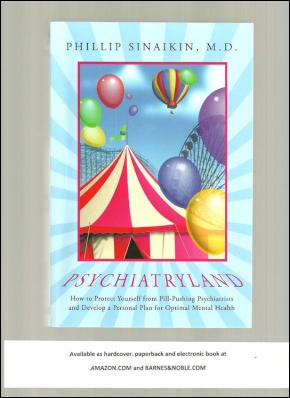Scoop News – July 25, 20011
By Martha Rosenberg

"Psychiatry mimics science but is not a real science. The symptoms it treats are subjective and have not been demonstrated and cannot be demonstrated at the cellular level."
Phillip Sinaikin, MD, is a Florida psychiatrist who has been in practice for 25 years. His new book focuses on excesses and industry influence in the field of psychiatry.
Rosenberg: Your new book, Psychiatryland, traces how deception, conflicts of interest, medical enabling and direct-to-consumer advertising have resulted in millions being on psychiatric drugs they don’t need. One patient you describe has legitimate mourning and grief work to do after his wife leaves him for his own cousin. But his grief is pathologized into “bipolar disorder” by the system, including his own mother.
Rosenberg: Can you explain the popularity of such drug cocktails? The drugs haven’t been tested together so the patient is a guinea pig. And their total cost can exceed $1000 per month, often shuttled onto taxpayers because the people are considered disabled under federal entitlement programs.
Sinaikin: Psychiatry mimics science but is not a real science. The symptoms it treats are subjective and have not been demonstrated and cannot be demonstrated at the cellular level. That gives psychiatrists free reign to just experiment and symptom chase, often insanely chasing the side effects and negative interactions of the current drug regimen with more and more drugs. Polypharmacy is also a way psychiatrists can distinguish themselves in an increasingly competitive market. No one believes you need a specialist for one drug — any primary care physician can give you Zoloft — but for multi-drug therapy you do. If you don’t write a prescription as a psychiatrist, you won’t work these days. It is like being a pacifist and having no choice but working in a bullet factory.
Rosenberg: A lot of this trial-and error polypharmacy is buttressed by the concept of “treatment resistance” and “Prozac poop-out.”
Sinaikin: I write in the book that an antidepressant not working anymore is no different than getting used to anything that used to thrill us. We buy our dream house with two bedrooms and a garage and after a while it doesn’t make us happy anymore and we are eyeing the house with three bedrooms and a pool. Another example, of course, is falling in and out of love.
Rosenberg: You document in Psychiatryland the creation of new diseases to sell drugs including adults now diagnosed with childhood disorders like ADD and children with adult disorders like bipolar and depression.
Sinaikin: One scientific article I read about the new childhood disorders sounds like a satire. Two well-respected “thought leaders” in psychiatry were debating the underlying pathology of a three-year-old girl who ran out in traffic. The first doctor believed her dangerous behavior was indicative of an Oppositional-Defiant disorder. The other doctor argued her impulsive act represented grandiose delusions where this girl believed she was special and cars could not harm her. She was, therefore, bipolar.
Rosenberg: Another shocker in your book is how everyday drug and alcohol addicts were recast as having psychiatric conditions for money.
Sinaikin: The insurance companies told the rehabs they would no longer pay for inpatient rehab for heroin, cocaine or alcohol unless there was also another Axis 1 psychiatric disorder like bipolar disorder or major depression. I was working in a drug treatment facility when the change happened. Since addicts typically complain of anxiety and depression, a completely understandable emotional response to their toxic lifestyles, it was “no problem” to add a new label and throw a few psychiatric drugs at their now relabeled “dual diagnosis.” Of course the central tenet of recovery, taking personal responsibility, was buried by the new victim narrative of self-medicating a previously undiagnosed mental illness.
Rosenberg: Treating addiction with psychiatric drugs before or instead of seeking a higher power is antithetical to the 12 Steps of Alcoholics Anonymous.
Sinaikin: As I say throughout my book, human beings are indescribably complex. There are times when the dual-diagnosis concept is necessary and helpful but clearly not applicable to 100% of the cases of addiction as it is now applied. I believe that the 12 Step model is an ideal model of recovery. Patients can have the help whenever they are truly ready, not just when someone decides to foist it on them. Most importantly, the addicts helping other addicts are doing it to facilitate their own recovery and not for ulterior motives such as money. Amazingly, in a world gone profit crazy 12 Step recovery programs are still free. I conceptualize the 12 Steps as a distillation of the spiritual principles world’s great religions but no one is forced to believe in anything including God.
Rosenberg: Given conflicts of interest at the American Psychiatric Association, which drives psychiatric diagnoses, in the FDA drug approval process itself and the legions of doctors willing to huckster for pharma as thought leaders or Key Opinion Leaders (KOLs), do you see any hope of rescuing people from Psychiatryland?
Sinaikin: The system is unbelievably bad and even worse than it looks. But, I think a goal that could be achieved would be a repeal of direct-to-consumer advertising. Patients now come into my office asking me if they have ADD or bipolar disorder or if they can have Cymbalta. When I began practicing psychiatry, long before direct-to-consumer advertising, this would never have happened.
Psychiatryland

